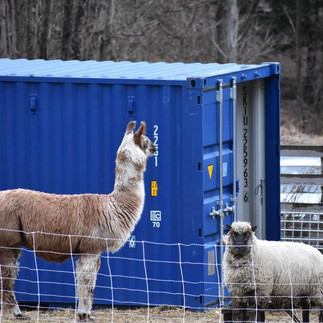Our Shipping Container Sheep Shelter
- Jen Manning

- Feb 18, 2023
- 4 min read
Updated: Mar 4, 2023
Using a shipping container for a sheep shelter remains one of the best decisions we've made to date as we've built out the farm operation. The 20ft shipping container provides shade and respite in summer, great protection from wind, rain and snow in harsh winters and the perfect lambing shed come spring.

If you're questioning whether you can use a shipping container as an animal shelter, the answer is unequivocally yes!
We tried and failed with plenty of other shelter options on what is a windy, south- facing hill farm. Our Shelterlogic animal shelter didn't play well on our rocky pasture and was easily loosened by our 200 Ib rams. It subsequently blew into the woods in what turned out to be quite a dangerous fashion [cue long metal stakes and 15ft posts flying everywhere in the dark].
Our handmade wooden pallet shelter lasted really well until met with 60mph winds. The container? Nailed it. Luckily, the container showed up the exact same day that our wooden shelter was finally obliterated by the wind.
There were a few must-have boxes we weren't sure a container would check and assumed we'd have to convert the shipping container to act as an animal shelter. We were, thankfully, wrong. In practice, the used shipping container provides everything you need for a livestock shelter almost as is:
1. Ventilation - It seems counterintuitive to keeping them out of the elements but all livestock, especially sheep, need a ventilated barn or shelter to avoid respiratory problems. Our plan was to take the doors off to make it a 3-sided structure, but in fact all we had to do was wedge one door permanently open and secure it – easy. We assumed we may have to cut the back and add additional vents, but the open door plus the existing (albeit small) vents in the container's side are more than sufficient.

2. Flooring - The container came with wooden floors but I'd read somewhere that they can contain toxic materials, which if you were building a tiny home you'd want to treat or replace. For me, that meant we should be careful for the sheep too.
A simple solution was to cover the floor entirely with rubber matting [common use for horse stalls]. This also means that the floor is far easier to clean of bedding, and it ensures the structure of the wooden floor underneath doesn't get wet or rotten.
3. Dimensions - we not only needed enough space for our flock of 8 sheep to hunker out of cold and wet conditions, but also for Sandman, our guard llama. He stands just under 6 ft tall. At 20 x 8 x 8 the container provides everyone plenty of space. It's recommended llamas have 40 sq. ft of indoor area and a bred ewe around12 sq. ft (less for rams) in open shed space - this gives our flock, and their lambs, that and some.
4. Weather Resistant – unlike tarp or wooden based shelters, nothing is knocking this container over. After-all if it's built to survive the Atlantic ocean it can deal with our windy sheep farm.
Even with the door permanently open, we've seen very little rusting in over a year's use and the doors still open and close perfectly. There's obviously no issue with snow load, and with it's height and size it has the added bonus of throwing great shade into the yard for the animals for the midday sun in summer.

5. Accessibility – both for the sheep and for us. There was a lot of back and forth [read, light arguments] as to where to place the container, but as luck would have it we had only one choice.
There was only one angle in which it would actually get through our fence gate and, given it came on a huge truck, only so far we could get it inside the pasture.
The container was dropped on levelling wooden logs along our lower fence line, which turned out to be the perfect spot for it to later become the center of the barn [or container] yard. For us it means we can keep them down and close to have eyes on them at certain points in the year such as lambing, and for the sheep their hay gets to them faster. All we had to do was add a small ramp to enable them to easily get in and out, and we were done.
Now we've had it in place for 18 months, our shipping container is not just a shelter but a fully functioning barn for us - it's where we shear the sheep, do our health-checks and management, and where we lamb.
We found very little online about converting a used shipping container into an animal shelter, but with shelter after shelter not working on our land, and knowing we didn't need the expense or scale of a pole barn, we went for it.
It's turned out to be a great investment – it'll last us a long while, the animals love it, and we think it looks great in the field too!
Jen























Comments